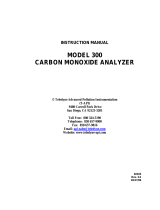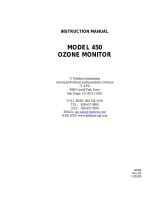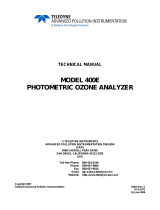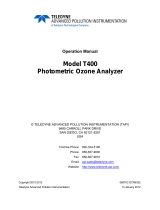Page is loading ...

INSTRUCTION MANUAL
MODEL 401
O
3
CALIBRATOR
© TELEDYNE INSTRUMENTS
ADVANCED POLLUTION INSTRUMENTATION DIVISION
(T-API)
9480 CARROLL PARK DRIVE
SAN DIEGO, CA 92121-5201
TOLL-FREE: 800-324-5190
FAX: 858-657-9816
TEL: 858-657-9800
E-MAIL: [email protected]
WEB SITE: www.teledyne-api.com
01124
REV. J2
Copyright 2005 Teledyne Advanced Pollution
Instrumentation
11 July, 2005

Teledyne API Model 401 O
3
Photometric Calibrator Instruction Manual, 01124, Rev. J2
SAFETY MESSAGES
Your safety and the safety of others is very important. We have provided many important safety
messages in this manual. Please read these messages carefully.
A safety message alerts you to potential hazards that could hurt you or others. Each safety
message is associated with a safety alert symbol. These symbols are found in the manual and
inside the instrument. The definition of these symbols is described below:
GENERAL WARNING/CAUTION
: Refer to the instructions for details on the
specific danger.
CAUTION
: Hot Surface Warning
CAUTION
: Electrical Shock Hazard
Technician Symbol
: All operations marked with this symbol are to be performed
by qualified maintenance personnel only.
CAUTION
The analyzer should only be used for the purpose
and in the manner described in this manual.
If you use the analyzer in a manner other than that for which
it was intended, unpredictable behavior could ensue with
possible hazardous consequences.
ii

Teledyne API Model 401 O
3
Photometric Calibrator Instruction Manual, 01124, Rev. J2
TABLE OF CONTENTS
SAFETY MESSAGES .......................................................................................... II
TABLE OF CONTENTS...................................................................................... III
LIST OF FIGURES.............................................................................................VII
LIST OF TABLES..............................................................................................VIII
1 INTRODUCTION............................................................................................1-1
1.1
PREFACE .........................................................................................................................................1-1
1.2
WARRANTY.....................................................................................................................................1-1
1.3 PRINCIPLE OF OPERATION ..............................................................................................................1-2
1.3.1 Interferent Rejection...............................................................................................................1-4
1.4 SPECIFICATIONS ..............................................................................................................................1-5
1.4.1 Noise (PPB RMS)....................................................................................................................1-6
1.4.2 Lower Detectable Limit (LDL) PPB.......................................................................................1-6
1.4.3 Zero Drift (PPB).....................................................................................................................1-6
1.4.4 Span Drift................................................................................................................................1-6
1.4.5 Linearity..................................................................................................................................1-6
1.4.6 Lag Time .................................................................................................................................1-6
1.4.7 Rise And Fall Times................................................................................................................1-6
1.4.8 Temperature Range.................................................................................................................1-6
1.4.9 Humidity Range ......................................................................................................................1-6
1.4.10 Flow Rates ............................................................................................................................1-7
1.4.11 Power....................................................................................................................................1-7
1.4.12 Weight...................................................................................................................................1-7
1.5
INSTALLATION AND OVERVIEW......................................................................................................1-7
1.6 ELECTRICAL AND PNEUMATIC CONNECTIONS ..............................................................................1-14
1.6.1 Electrical Connections..........................................................................................................1-14
1.6.2 RS-232...................................................................................................................................1-14
1.6.3 Pneumatic System .................................................................................................................1-16
1.6.4 Exhaust Connections (See Figure 1-5).................................................................................1-16
1.6.5 Output Flow Adjustment.......................................................................................................1-16
1.7
OPERATION VERIFICATION............................................................................................................1-20
1.7.1 Final Test And Calibration Values.......................................................................................1-21
1.8 OPTIONS........................................................................................................................................1-22
1.8.1 Rack Mount With Slides........................................................................................................1-22
1.8.2 Status Outputs.......................................................................................................................1-22
2 OPERATION .................................................................................................. 2-1
2.1
KEY FEATURES ...............................................................................................................................2-1
2.1.1 O
3
Readout..............................................................................................................................2-1
iii

Teledyne API Model 401 O
3
Photometric Calibrator Instruction Manual, 01124, Rev. J2
2.1.2 O
3
Analog Output....................................................................................................................2-1
2.1.3 E
2
ROM Backup Of Software Configuration..........................................................................2-1
2.1.4 Adaptive Filter........................................................................................................................2-1
2.1.5 Data Acquisition .....................................................................................................................2-2
2.1.6 RS-232 Interface .....................................................................................................................2-2
2.1.7 Password Protection...............................................................................................................2-2
2.2
FRONT PANEL .................................................................................................................................2-4
2.2.1 Front Panel Display................................................................................................................2-4
2.2.2 Programmable Pushbuttons ...................................................................................................2-7
2.2.3 Status LEDs.............................................................................................................................2-9
3 CALIBRATION............................................................................................... 3-1
3.1
MANUAL ZERO AIR SUPPLY............................................................................................................3-1
3.2
MANUAL O
3
GENERATION ..............................................................................................................3-1
3.3
AUTOMATIC ZERO/SPAN (OR MULTIPOINT) CHECK ........................................................................3-2
3.4
MANUAL ZERO/SPAN (OR MULTI-POINT) CHECK ...........................................................................3-2
3.5
SUMMARY OF FRONT PANEL CALIBRATION CONTROLS..................................................................3-3
3.6
PHOTOMETER CALIBRATION ...........................................................................................................3-3
3.7
REMOTE ZERO/SPAN CHECK (CONTACT CLOSURE)........................................................................3-4
3.8
REMOTE ZERO/SPAN CHECK OR ADJUSTMENT (RS-232)...............................................................3-5
3.9
HOLD OFF .......................................................................................................................................3-5
4 SETUP MODE................................................................................................ 4-1
4.1
SETUP MODE OPERATION ...............................................................................................................4-1
4.2
SETTING AUTOMATIC MULTIPOINT (ASEQ) CHECK.......................................................................4-1
4.3
SETTING AUTOMATIC ZERO/SPAN DURATION.................................................................................4-1
4.4
EXAMINING THE OZONE FORMULA SLOPE AND OFFSET.................................................................4-2
4.5
SETTING THE O
3
GENERATION MODE .............................................................................................4-3
4.5.1 BNCH Mode............................................................................................................................4-3
4.5.2 REF Mode...............................................................................................................................4-3
4.5.3 CNST Mode.............................................................................................................................4-3
4.6
SETTING THE TIME-OF-DAY...........................................................................................................4-3
4.7
SETTING THE DATE.........................................................................................................................4-3
4.8
ADJUSTING THE CLOCK SPEED .......................................................................................................4-4
4.9
SETTING THE O
3
CONCENTRATION RANGE .....................................................................................4-4
4.10
SETTING THE ANALOG OUTPUT OFFSET .......................................................................................4-4
4.11
SETTING THE RS-232 BAUD RATE................................................................................................4-4
4.12
SETTING THE ANALYZER I.D........................................................................................................4-5
4.13
DISABLING THE CALIBRATION PASSWORD ...................................................................................4-5
4.14
SETTING THE FAULT LED TIMEOUT.............................................................................................4-5
4.15
SOFTWARE CONFIGURATION.........................................................................................................4-6
4.16
SUMMARY OF SETUP VARIABLES .................................................................................................4-6
5 DIAGNOSTICS............................................................................................... 5-1
5.1
TEST MEASUREMENTS ....................................................................................................................5-1
5.2 DIAGNOSTIC TESTS .........................................................................................................................5-1
iv

Teledyne API Model 401 O
3
Photometric Calibrator Instruction Manual, 01124, Rev. J2
5.2.1 D/A Output..............................................................................................................................5-2
6 HANDLING WARNINGS................................................................................ 6-1
7 RS-232 COMMUNICATIONS......................................................................... 7-1
7.1 DAS REPORTING.............................................................................................................................7-2
7.2
WARNINGS......................................................................................................................................7-3
7.3
STATUS/CONTROL...........................................................................................................................7-4
7.4
DIAGNOSTICS..................................................................................................................................7-6
7.5 TEST MEASUREMENTS ....................................................................................................................7-7
7.6
VIEWING AND MODIFYING VARIABLES ..........................................................................................7-8
8 ADJUSTMENTS............................................................................................. 8-1
8.1
POWER SUPPLY BOARD ADJUSTMENT.............................................................................................8-1
8.1.1 Box Temperature Limits..........................................................................................................8-1
8.2
A/D - D/A CALIBRATION PROCEDURE ............................................................................................8-3
8.3
OUTPUT VOLTAGE RANGE CHANGES..............................................................................................8-4
8.4
FLOW READOUT ADJUSTMENT........................................................................................................8-4
8.5
DC POWER SUPPLY.........................................................................................................................8-6
8.6
CPU................................................................................................................................................8-6
8.7
STATUS LINES.................................................................................................................................8-7
8.8
UV LAMP POWER SUPPLY ADJUSTMENT ........................................................................................8-7
8.9
OZONE GENERATOR LAMP SETUP...................................................................................................8-8
8.10
OZONE GENERATOR CALIBRATION...............................................................................................8-9
8.11
DARK CURRENT SIGNAL ADJUST PROCEDURE..............................................................................8-9
8.12
BENCH FEEDBACK OPTION..........................................................................................................8-10
9 TROUBLESHOOTING ................................................................................... 9-1
9.1
OVERVIEW ......................................................................................................................................9-1
9.2
TROUBLESHOOTING FUNDAMENTAL CALIBRATOR OPERATION ......................................................9-1
9.2.1 Checking The Power Sub-Systems..........................................................................................9-2
9.2.2 Checking The CPU And Display.............................................................................................9-3
9.2.3 Checking The Keyboard..........................................................................................................9-3
9.3
TROUBLESHOOTING USING WARNING MESSAGES...........................................................................9-3
9.4
TROUBLESHOOTING USING TEST FUNCTION VALUES .....................................................................9-5
9.5
TROUBLESHOOTING DYNAMIC PROBLEMS ......................................................................................9-6
9.5.1 Noisy Or Unstable Readings At Zero .....................................................................................9-7
9.5.2 Noisy, Unstable, Or Non-Linear Span Readings....................................................................9-7
9.5.3 Slow Response To Changes In Concentration........................................................................9-7
9.5.4 Analog Outputs Do Not Agree With Front Panel Readings...................................................9-8
9.5.5 Cannot Zero............................................................................................................................9-8
9.5.6 Cannot Span............................................................................................................................9-8
9.6
TROUBLESHOOTING INDIVIDUAL SUB-ASSEMBLIES AND COMPONENTS.........................................9-9
9.6.1 Troubleshooting Flow Problems ............................................................................................9-9
9.6.2 Troubleshooting Temperature Problems..............................................................................9-10
9.6.3 Checking The V/F Card........................................................................................................9-11
v

Teledyne API Model 401 O
3
Photometric Calibrator Instruction Manual, 01124, Rev. J2
9.6.4 Checking The DC Power Supply Board................................................................................9-13
9.6.5 Checking The Pneumatic Sensor Board ...............................................................................9-14
9.6.6 Checking The Source Lamp And Detector............................................................................9-14
9.6.7 Checking Main Switching Valve...........................................................................................9-16
9.6.8 Checking The Lamp Power Supply.......................................................................................9-16
9.7
WARRANTY/REPAIR QUESTIONNAIRE.........................................................................................9-18
10 ROUTINE MAINTENANCE........................................................................ 10-1
10.1
MAINTENANCE SCHEDULE..........................................................................................................10-1
10.2
LEAK CHECKING .........................................................................................................................10-2
10.3
CLEANING OF SAMPLE CELL.......................................................................................................10-2
10.4 CHANGING THE PROM.................................................................................................................10-3
11 MODEL 401 SPARE PARTS AND EXPENDABLES KITS........................ 11-1
11.1
SPARE PARTS FOR CE MARK UNITS ...........................................................................................11-1
11.2
SPARE PARTS FOR NON-CE MARK UNITS ..................................................................................11-3
Appendix A LIST OF AVAILABLE MODEL 401 OPTIONS .................................................A-1
Appendix B RECOMMENDED ZERO AIR SYSTEM............................................................. B-1
Appendix C REFERENCES....................................................................................................... C-1
Appendix D SOFTWARE MENU TREES ................................................................................D-1
Appendix E ELECTRICAL SCHEMATIC INDEX ...................................................................E-1
vi

Teledyne API Model 401 O
3
Photometric Calibrator Instruction Manual, 01124, Rev. J2
LIST OF FIGURES
FIGURE 1-1: MODEL 401 OZONE CALIBRATOR BLOCK DIAGRAM..........................................................1-11
F
IGURE 1-2: M401 REAR PANEL ELECTRICAL CONNECTIONS................................................................1-12
F
IGURE 1-3: REAR PANEL ELECTRICAL AND PNEUMATIC CONNECTIONS (CE VERSION).......................1-13
F
IGURE 1-4: RS-232 PIN ASSIGNMENTS.................................................................................................1-15
F
IGURE 1-5: M401 CALIBRATOR PNEUMATIC CONNECTIONS ................................................................1-17
F
IGURE 1-6: M401 REAR PANEL (EXTERNAL DRY ZERO AIR)...............................................................1-18
F
IGURE 1-7: M401 CALIBRATOR CHASSIS LAYOUT...............................................................................1-19
F
IGURE 2-1: MODEL 401 FRONT PANEL...................................................................................................2-4
FIGURE 2-2: ILLUSTRATION OF NORMAL DISPLAY ..................................................................................2-8
F
IGURE 8-1: ELECTRICAL BLOCK DIAGRAM ............................................................................................8-2
F
IGURE 8-2: FLOW AND PRESSURE READOUT ADJUSTMENT....................................................................8-5
F
IGURE A-1: MODEL 401 SAMPLE SOFTWARE MENU TREE....................................................................D-1
F
IGURE A-2: MODEL 401 SETUP SOFTWARE MENU TREE.......................................................................D-2
vii

Teledyne API Model 401 O
3
Photometric Calibrator Instruction Manual, 01124, Rev. J2
LIST OF TABLES
TABLE 1-1: TEST VALUES.......................................................................................................................1-21
T
ABLE 2-1: PASSWORD LEVELS ...............................................................................................................2-3
T
ABLE 2-2: SYSTEM MODES ....................................................................................................................2-5
T
ABLE 2-3: TEST MEASUREMENTS ..........................................................................................................2-6
T
ABLE 2-4: WARNING MESSAGES............................................................................................................2-7
T
ABLE 2-5: STATUS LEDS........................................................................................................................2-9
T
ABLE 3-1: CALIBRATION CONTROLS......................................................................................................3-3
T
ABLE 4-1: SETUP VARIABLES.................................................................................................................4-7
TABLE 5-1: TEST CHANNEL OUTPUT........................................................................................................5-2
T
ABLE 5-2: DIAGNOSTIC TESTS ...............................................................................................................5-2
T
ABLE 7-1: RS-232 MESSAGE TYPES ......................................................................................................7-1
T
ABLE 7-2: WARNING MESSAGE CLEAR COMMANDS..............................................................................7-4
T
ABLE 7-3: STATUS REPORTS ..................................................................................................................7-4
T
ABLE 7-4: CONTROL COMMANDS...........................................................................................................7-5
T
ABLE 7-5: DIAGNOSTIC COMMANDS ......................................................................................................7-6
T
ABLE 7-6: SPECIAL DIAGNOSTIC COMMANDS........................................................................................7-7
T
ABLE 7-7: DIAGNOSTIC REPORTS...........................................................................................................7-7
T
ABLE 7-8: TEST MEASUREMENT REQUEST COMMANDS.........................................................................7-8
T
ABLE 7-9: RS-232 VARIABLE NAMES..................................................................................................7-10
T
ABLE 8-1: THE CALIBRATOR HAS THE FOLLOWING STATUS CONDITIONS.............................................8-7
T
ABLE 9-1: WARNING MESSAGES............................................................................................................9-4
T
ABLE 9-2: TEST FUNCTION VALUES.......................................................................................................9-5
T
ABLE 9-2: TEST FUNCTION VALUES (CONTINUED) ................................................................................9-6
T
ABLE 9-3: V/F BOARD JUMPERS - FACTORY SETTINGS........................................................................9-12
T
ABLE 9-4: V/F BOARD DIP SWITCHES - RANGES FOR ANALOG OUTPUT..............................................9-12
T
ABLE 9-5: UV SOURCE LAMP AND DETECTOR DIAGNOSTICS..............................................................9-15
T
ABLE 10-1: MAINTENANCE SCHEDULE ................................................................................................10-1
T
ABLE 11-1: SPARE PARTS FOR CE MARK UNITS..................................................................................11-1
T
ABLE 11-1: SPARE PARTS FOR CE MARK UNITS (CONTINUED)...........................................................11-2
T
ABLE 11-2: SPARE PARTS FOR NON-CE MARK UNITS.........................................................................11-3
T
ABLE 11-2: SPARE PARTS FOR NON-CE MARK UNITS (CONTINUED) ..................................................11-4
T
ABLE A-1: AVAILABLE MODEL 401 OPTIONS.......................................................................................A-1
T
ABLE E-1: ELECTRICAL SCHEMATIC INDEX ...........................................................................................E-1
viii

Teledyne API Model 401 O
3
Photometric Calibrator Instruction Manual, 01124, Rev. J2
1 INTRODUCTION
1.1 Preface
Teledyne API is pleased that you have purchased the Model 401. We offer a full one year
warranty (see Section 1.2) and we at Teledyne API will be pleased to provide you with any
support required so that you may utilize our equipment to the fullest extent.
The Teledyne API Model 401 keyboard/operator interface with its "talking keys" makes the
Teledyne API a very user-friendly system. We hope you will not experience any problems with
the Teledyne API Model 401 but if you do, the built-in tests and diagnostics should allow you to
quickly and easily find the problem. In addition, our full time customer service department is
always available to answer your questions.
1.2 Warranty
WARRANTY POLICY (02024c)
Prior to shipment, Teledyne API equipment is thoroughly inspected and tested. Should
equipment failure occur, Teledyne API assures its customers that prompt service and support
will be available.
COVERAGE
After the warranty period and throughout the equipment lifetime, Teledyne API stands ready to
provide on-site or in-plant service at reasonable rates similar to those of other manufacturers in
the industry. All maintenance and the first level of field troubleshooting is to be performed by
the customer.
NON-TELEDYNE API MANUFACTURED EQUIPMENT
Equipment provided but not manufactured by Teledyne API is warranted and will be repaired to
the extent and according to the current terms and conditions of the respective equipment
manufacturers warranty.
GENERAL
Teledyne API warrants each Product manufactured by Teledyne API to be free from defects in
material and workmanship under normal use and service for a period of one year from the date of
delivery. All replacement parts and repairs are warranted for 90 days after the purchase.
If a Product fails to conform to its specifications within the warranty period, Teledyne API shall
correct such defect by, in Teledyne API's discretion, repairing or replacing such defective
Product or refunding the purchase price of such Product.
1-1

Teledyne API Model 401 O
3
Photometric Calibrator Instruction Manual, 01124, Rev. J2
The warranties set forth in this section shall be of no force or effect with respect to any Product:
(i) that has been altered or subjected to misuse, negligence or accident, or (ii) that has been used
in any manner other than in accordance with the instruction provided by Teledyne API or (iii)
not properly maintained.
THE WARRANTIES SET FORTH IN THIS SECTION AND THE REMEDIES
THEREFORE ARE EXCLUSIVE AND IN LIEU OF ANY IMPLIED WARRANTIES OF
MERCHANTABILITY, FITNESS FOR PARTICULAR PURPOSE OR OTHER
WARRANTY OF QUALITY, WHETHER EXPRESSED OR IMPLIED. THE
REMEDIES SET FORTH IN THIS SECTION ARE THE EXCLUSIVE REMEDIES FOR
BREACH OF ANY WARRANTY CONTAINED HEREIN. TELEDYNE API SHALL
NOT BE LIABLE FOR ANY INCIDENTAL OR CONSEQUENTIAL DAMAGES
ARISING OUT OF OR RELATED TO THIS AGREEMENT OF TELEDYNE API'S
PERFORMANCE HEREUNDER, WHETHER FOR BREACH OF WARRANTY OR
OTHERWISE.
TERMS AND CONDITIONS
All units or components returned to Teledyne API should be properly packed for handling and
returned freight prepaid to the nearest designated Service Center. After the repair, the equipment
will be returned, freight prepaid.
1.3 Principle Of Operation
M401 Ozone calibrator consist of two major parts; the ozone generating device and the
photometer. Ozone generating device itself also consist of a pump, an air scrubber to self-
generate zero air, a pressure regulator to control flow rate, an ozone generator using UV lamp,
and a manifold. The pressure regulator provides very stable flow of zero air through the O
3
generator, while the light intensity of the UV lamp is controlled to generate accurate and stable
ozone output.
The photometer is used as part of a feedback lamp control to assure stable O
3
output even during
changing conditions. The photometer is compensated for both pressure and temperature
variations. This true photometer operation along with self-generated zero air results in a
completely self-contained O
3
generating system.
The detection of ozone molecules of the photometer is based on absorption of 254 nm UV light
due to an internal electronic resonance of the O
3
molecule. The Model 401 Photometer uses a
mercury lamp constructed so that a large majority of the light emitted is at the 254nm
wavelength. Light from the lamp shines down a hollow glass tube that is alternately filled with
sample gas, then filled with zero air. The ratio of the intensity of light passing through the zero
air to that of the sample forms a ratio I/I
o
. This ratio forms the basis for the calculation of the
ozone concentration.
1-2

Teledyne API Model 401 O
3
Photometric Calibrator Instruction Manual, 01124, Rev. J2
NOTE
Model 401 Photometric Calibrator is designed to be a dedicated
calibrator. The M401 Photometer should not be used as a monitor.
The Beer-Lambert equation, shown below, calculates the concentration of ozone from the ratio
of light intensities.
0
0
9
I
I
n
P
inHg92.29
K273
T
a
10
O
C
3
l
l
×××
×
−=
Where:
I
= Intensity of light passed through the sample
0
I = Intensity of light through sample free of ozone
a
= absorption coefficient
l
= path length
C
= concentration of ozone in ppm
T
= sample temperature in Kelvin
P
= pressure in inches of mercury
nl
= natural logarithm
As you can see the concentration of ozone depends on more than the intensity ratio. Temperature
and pressure influence the density of the sample. The density changes the number of ozone
molecules in the absorption tube which impacts the amount of light removed from the light
beam. These effects are addressed by directly measuring temperature and pressure and including
their actual values in the calculation. The absorption coefficient is a number that reflects the
inherent ability of ozone to absorb 254 nm light. Most current measurements place this value at
308 cm
-1
atm
-1
at STP. The value of this number reflects the fact that ozone is a very efficient
absorber of UV radiation which is why stratospheric ozone protects the life forms lower in the
atmosphere from the harmful effects from solar UV radiation. Lastly, the absorption pathlength
determines how many molecules are present in the column of gas in the absorption tube.
1-3

Teledyne API Model 401 O
3
Photometric Calibrator Instruction Manual, 01124, Rev. J2
The intensity of light is converted into a voltage by the detector/preamp module. The voltage is
converted into a number by a voltage-to-frequency (V/F) converter capable of 80,000 count
resolution. The digitized intensities, along with the other variables, are used by the CPU to
compute the concentration using the above formula.
Every 8 seconds the M401 Photometer completes a measurement cycle consisting of a 2 second
wait period for the sample tube to flush, followed by 2 seconds of measuring the average light
intensity to determine I. The sample valve is switched to admit scrubbed sample gas for 2
seconds followed by 2 seconds measuring the average light intensity to obtain I
o
. Measurement
of the I
o
every 8 seconds minimizes instrument drift due to changing intensity of the lamp due to
aging and dirt. The 120 sec filter provides 32 averages.
1.3.1 Interferent Rejection
It should be noted that the UV absorption method for detecting ozone is subject to interference
from a number of sources. The Model 401 has been successfully tested for its ability to reject
interference from sulfur dioxide, nitrogen dioxide, nitric oxide, water, and meta-xylene.
While the instrument rejected interference from the aromatic hydrocarbon meta-xylene, it should
be noted that there are a very large number of volatile aromatic hydrocarbons that could
potentially interfere with ozone detection. If the Model 401 is installed in an environment where
high aromatic hydrocarbon concentrations are suspected, specific tests should be conducted to
reveal the amount of interference these compounds may be causing.
1-4

Teledyne API Model 401 O
3
Photometric Calibrator Instruction Manual, 01124, Rev. J2
1.4 Specifications
Photometer
Ranges User selectable to any full scale range from 100 ppb to 20,000 ppb
Zero Noise < 0.3 ppb (rms)
Span Noise < 0.5% of reading (rms)
Lower Detectable Limit < 0.6 ppb (rms)
Zero Drift (24 hours) < 1.0 ppb*
Zero Drift (7 days) < 1.0 ppb*
Span Drift (24 hours) 1% of reading *
Span Drift (7 days) 2% of reading *
Linearity Better than 1% FS
Precision 1.0 ppb
Lag Time 10 sec
Rise/Fall Time (95%) <20 sec
Sample Flow Rate
800 cc/min ± 10%
Temperature Range
5-40° C
Humidity Range 0-95% RH, Non-Condensing
Temp Coefficient
< 0.05 % per °C
Voltage Coefficient < 0.05 % per V
Dimensions HxWxD 7" x 17" x 27" (178 mm x 432 mm x 686 mm)
Weight, Analyzer 60 lb. (27 kg)
Power, Analyzer 110v/60Hz, 220v/50Hz 250 watts
Environmental Conditions Installation Category (Overvoltage Category) II
Pollution Degree 2
Recorder Instantaneous
± 100 mV, ± 1 v
(Bi-Polar)
± 5 v, ± 10 v
Status 12 Status Outputs from Opto-Isolators
Calibration Ozone Generator
Flow rate 2 to 5 LPM adjustable
Maximum concentration 1.0 ppm @ 5 LPM
Minimum concentration 0.050 ppm @ 2 LPM
Stability
± 0.002 ppm (bench feedback)
* at constant temperature and voltage
1-5

Teledyne API Model 401 O
3
Photometric Calibrator Instruction Manual, 01124, Rev. J2
1.4.1 Noise (PPB RMS)
The standard deviation of reported concentration calculated over 25 samples times 7 runs
minimum, N-1 weighted.
1.4.2 Lower Detectable Limit (LDL) PPB
LDL is defined as twice the (RMS) noise at the lower end of the most sensitive operating range.
1.4.3 Zero Drift (PPB)
Zero drift is defined as unadjusted (automatic) operation maximum shift over the given period at
constant temperature and pressure.
1.4.4 Span Drift
Span drift is defined similarly to zero drift, requiring unadjusted operation at constant
temperature and pressure.
1.4.5 Linearity
< 1.0% of URL, best-straight-line deviation over range of LDL to URL.
1.4.6 Lag Time
Lag time is defined as the time interval between a step change, at the sample inlet port, of input
concentration and the first observable corresponding change in analyzer output.
1.4.7 Rise And Fall Times
Rise/fall times are defined as the time interval between a step change in input concentration and
95% of final response unless otherwise noted.
1.4.8 Temperature Range
5-40° C.
1.4.9 Humidity Range
0 to 95% relative humidity, non-condensing.
1-6

Teledyne API Model 401 O
3
Photometric Calibrator Instruction Manual, 01124, Rev. J2
1.4.10 Flow Rates
800 scc/min ± 10% (standard cubic centimeters/minute) sample flow rate.
2-5 l/min ± 10% (standard cubic liter/minute) O
3
generator flow rate.
1.4.11 Power
Standard input power: 120VAC rms, 60 Hz, 250 watts maximum and 220, 240 V, 50 Hz.
5A resettable circuit breaker.
1.4.12 Weight
27 Kg (60 lb.) maximum.
1.5 Installation And Overview
The Model 401 is shipped with the following standard equipment:
1. Power cord.
2. Instruction manual.
CAUTION
To avoid personal injury, always use two persons to lift and carry
the Model 401.
Upon receiving the Model 401 please do the following:
1. Verify no apparent shipping damage. (If damage has occurred please advise shipper first,
then Teledyne API.)
2. Remove all red colored shipping screws from the underside of the instrument. Note: Save
these shipping screws and re-install them whenever the unit is shipped to another location.
3. When installing the Model 401, allow a minimum of 4 inches (100mm) of clearance at the
back of the instrument and 1 inch (25mm) of clearance on each side for proper ventilation.
4. Check that all options ordered are enclosed.
5. Connect analyzer' sample inlet line to the M401 sample port of manifold on rear panel.
1-7

Teledyne API Model 401 O
3
Photometric Calibrator Instruction Manual, 01124, Rev. J2
NOTE
See Figure 1-4 for rear panel pneumatic connections. Span gas
should only come into contact with PTFE or glass. Leak check
all fittings with soap solution.
Maximum pressure for leak check is 15 PSIG.
6. Connect the pump exhaust to a suitable vent outside the analyzer area.
CAUTION
Connect the exhaust fitting on the rear panel (see Figure 1-5) to a
suitable vent outside the analyzer area.
7. For internal pressurized zero air using an external dry air supply connect AIR IN port to a
clean, dry air supply (see Figure 1-6).
NOTE
For best O
3
generator stability and to avoid moisture condensation,
it is recommended that zero air be dried to approximately -20°C dew
point.
For external pressurized dry zero air using an external dry pressurized source (see Figure 1-
6) proceed as follows:
a. Remove cap plug from the tee of zero air scrubber assembly and connect external dry
zero air line instead (air pressure should be about 30-40 psi).
b. Install the cap plug to dry air inlet port.
c. Verify the power is off and unplug O
3
GENERATOR pump's power cable connector.
8. Connect a recording device to the terminal strip connections on the rear panel (see
Figure 1-2). See Table 9-4 for setting proper analog output voltage jumpers.
9. Connect the power cord to an appropriate power outlet (see the serial number tag for correct
voltage and frequency).
NOTE
Power plug must have ground lug.
1-8

Teledyne API Model 401 O
3
Photometric Calibrator Instruction Manual, 01124, Rev. J2
10. Turn on the M401 by switching the switch on the lower right corner of the front panel (See
Figure 2-1). The front panel display should light with a sequence of messages,-API - M401 -
software version number, then a normal display as shown in Figure 2-2.
11. Allow about 60 minutes for the temperatures to come up to their respective setpoints then
press the leftmost button on the front keyboard to scroll through the TEST values. Compare
these values to those noted during the final factory checkout listed in Table 1-1. The values
observed should closely match the Table 1-1 values.
NOTE
Words in all caps are messages on the analyzer front panel.
12. Select the range the analyzer will be calibrated on.
a. From the MAIN menu press SETUP to enter the SETUP menu. (See Figure 2-2 for
appearance of front panel.)
b. Press MISC.
c. Press D/A.
d. Enter the PASSWORD (818).
e. Press RNGE (RANGE).
f. Enter the derived full scale range for analog outputs and press ENTR. (Example: if full
scale range is 500 ppb, then press corresponding digit's button until desired range is
selected and press ENTR.)
g. Press EXIT 3 times to return to the MAIN menu.
13. O
3
generator flow adjustment. The O
3
generator flow is controlled by a precision pressure
regulator and flow restrictor. Increasing upstream pressure of flow restrictor will increase
flowrate and vice versa. In order to increase pressure, adjust knob clockwise as needed while
monitoring the O
3
flow test measurement display. In general, the O
3
generator flow should be
at least 1 L/MIN in addition of total flow demands for the Model 401 (800 cc/min) and
remote analyzers.
NOTE
Adjustment of the O
3
generator flow is to be performed by qualified
maintenance personnel only.
1-9

Teledyne API Model 401 O
3
Photometric Calibrator Instruction Manual, 01124, Rev. J2
14. Generate the Zero Air.
a. Press ZERO from the main menu and enter the password (512).
b. Press STBY to terminate or press O
3
GN to continue to generate O
3
span gas.
15. Generate the O
3
Span Gas.
a. Press O
3
GN from the main menu and enter the password (512).
b. Enter the O
3
concentration value desired (0.05 - 1 ppm range).
c. Press CONC in order to change O
3
gas concentration while generating specified O
3
gas.
d. Press STBY to terminate O
3
gas generation or press zero to continue to generate zero air.
1-10

Teledyne API Model 401 O
3
Photometric Calibrator Instruction Manual, 01124, Rev. J2
Figure 1-1: Model 401 Ozone Calibrator Block Diagram
1-11

Teledyne API Model 401 O
3
Photometric Calibrator Instruction Manual, 01124, Rev. J2
8.7
Figure 1-2: M401 Rear Panel Electrical Connections
1-12
/










